
SP 5199 with LED Lighting using Walthers Trucks and OMM 10001 Pickups.
OMM #10001 inclueds parts to build all-wheel pickups for two Walthers Passenger Cars. This is enough to equip two sets of passenger car trucks. The kit includes one 'fret' of bronze etchings with screw holes and folding lines to create the pickup contact lugs. This product is designed to be used with 30 Gage wire, such as TCS's decoder wire. Note: The newer "Mainline" Series Walthers Passenger Cars use plastic trucks which will not work with this kit. Only the Walthers cars with metal trucks will work.
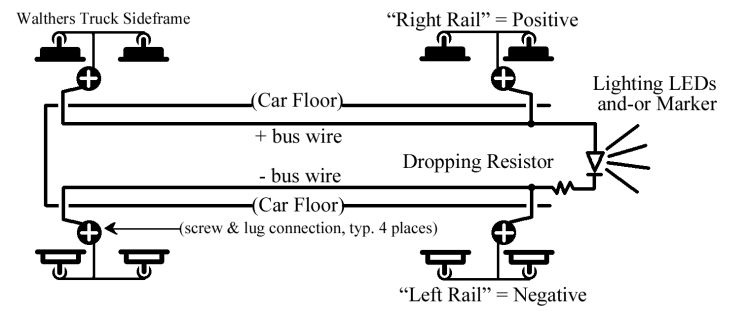
Wiring Diagram of a passenger car with pickups installed and a Marker Light or interior light installed. Note: This diagram is for straight track powered lighting - a constant lighting circuit could be installed as well.

The etched lugs are easily soldered to and folded to provide strain relief on the wires while the trucks pivot freely while negotiating curves in the track.
These Lugs are designed to replace the stamped steel pickup wipers in Walthers passenger cars above the trucks and provide positive flexible power from the track to any lighting kits or DCC decoders inside the car body. The Lugs are also designed to be used on any passenger car refitted with Walthers Passenger Trucks. As long as the trucks are the type with screw-mounted cast metal sideframes the Lugs can be used. This means both 6-wheel and 4-wheel passenger trucks can be used.
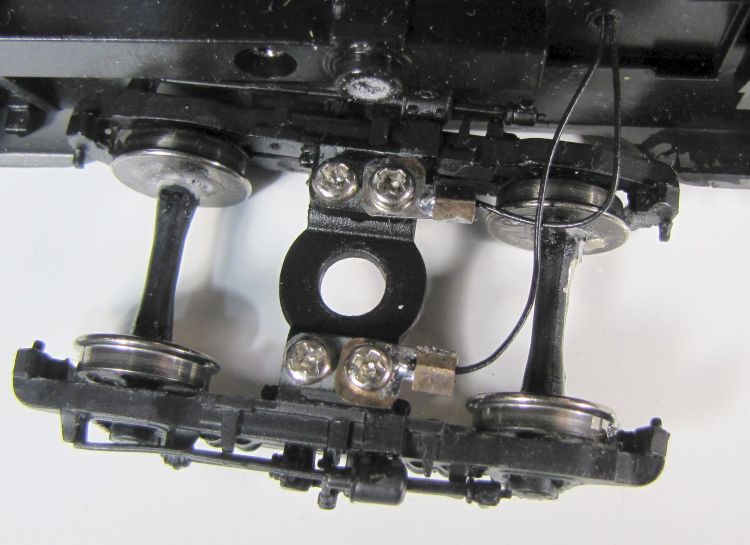
Use these lugs to add reliable power connection to cars with Walthers Passenger Trucks having all-wheel pickup. Shown here on Walthers Pullman 4-wheel truck for LW cars.
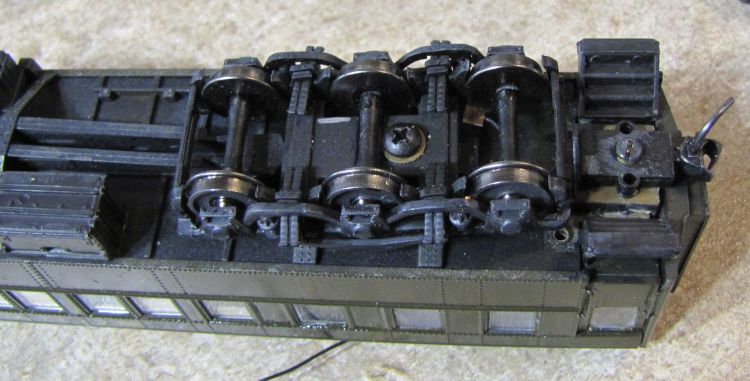
Walthers 6-wheel Passenger Trucks with OMM 10001 installed and wired.

LED lighting inside modified Walthers Paired-Window Coach.
Many different forms of lighting can be used in model passenger cars. Anything from 12-14V bulbs, to LEDs, and LEDs mounted on PC-board strips. One point worth considering is how bright you want the interior lights on your passenger cars to be, which is best done in comparison with the normal room lighting of the layout the cars will be running on. If the room is normally lit for 'daytime' the interior lights on the cars should be dimmer than the surrounding light, very few artifical lighting systems in the world can compare directly with natural sunlight! As the layout lighting is turned down, or off, then the interior lighting should be visiable, but not overpowering. Remember, we're not modeling a nuclear reactor inside each passenger car that turns the steel bodies translucent! Often a nice balance can be achived with dropping resistors on the lighting system in the car to give a nice glow when the layout lighting is dim or off, but isn't overpowering during the 'daytime' or at 'night'.

White styrene reflector installed on upgraded Model Power coach/chair car.

LED lighting installed on SP lounge car 2938.
More Information will be added in this section with examples of applications soon!
Markers are required by law on North American Railroads. They can be anything from a red flag or panel on the last car of the train by day, to a red-glassed oil lantern or electric light by night.
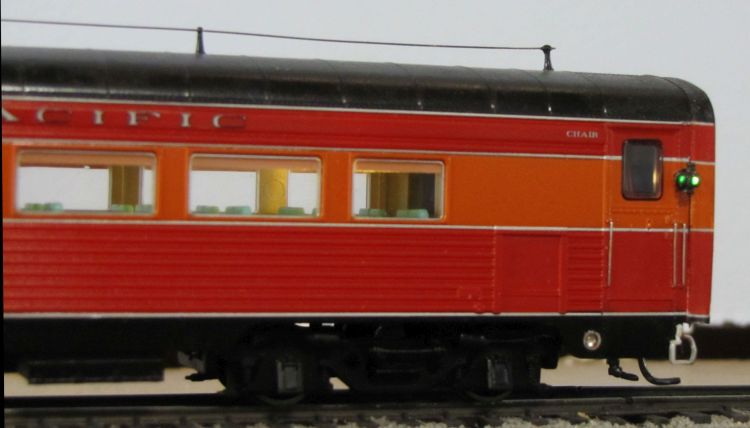
Tomar's Adlake markers installed on MTH Daylight Articulated Chair Car really can now only be used on the end of the train.
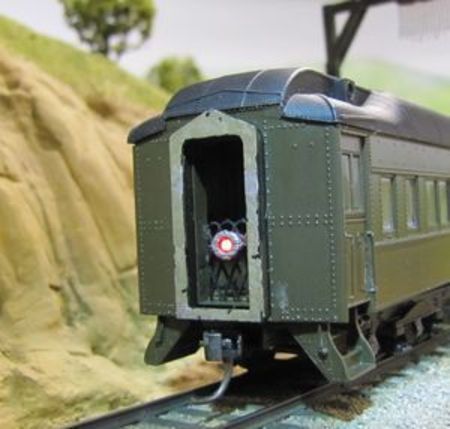
OMM 10001 Marker installed on Walthers 12-1 Pullman Sleeper.
Because the OwlMtModels Gyralite Marker is mounted inside the diaphragm of the car, it can be hidden when coupled mid-train, allowing for many different cars to be fitted with working markers to run at the rear of their trains, but also easily be moved around or replaced with extra or different cars if needed.
Various types of electric markers came into use during the 1950s as the kerosene lanterns were being converted to electric lights or replaced with other forms of markers (Gyralites and “box lights”). On the Southern Pacific, Union Pacific, and Chicago Northwestern, the push towards electric markers started in 1936 with the City of San Francisco's tailcar having built-in electric markers to denote the rear of the train. The Southern Pacific followed the next year, in 1937, also with built-in electric markers and a large “signal light” built-in the rear car of Pullman's new streamlined “Daylight” between San Francisco and Los Angeles.
_Marker_lights-REV-A.jpg)
Over the years SP's Rulebooks show the adoption of the “electric signal light” combined with the standard lighted markers. The Pyle Gyralite is a combination of the two. It is often seen on the front of SP locomotives with a red lens. Some of these Gyralites still had functional mechanisms to produce the signature “Gyralite Effect” strobing. Union Pacific, Great Northern and several other railroads are known to have also used Pyle Gyralites in passenger marker service.
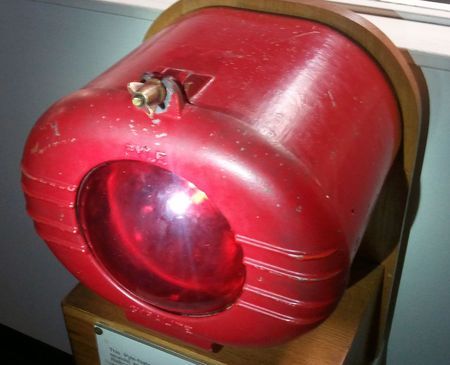
For modelers, the stobing effect can be simulated with various after-market lighting circuits or lighting-function-only DCC decoders (not included in the OwlMtModels 10002 kit). Modelers wishing to have a brighter flash on the strobe effect should use a resistor between 600-800 Ohms. This will give the desired “Pop” to the light at the brightest setting. The included 1000 Ohm resistor is very satisfactory for the “glow,” visible from 30-50 real feet away, and is not overpowering when viewed at only a few feet away.
Markers were owned by the railroads and were changed out when a train continued onto another railroad's operating control. SP and UP would change crews and markers on passenger trains at Ogden, Utah, for example. SP's Gyralites were known to be painted silver in most cases, but they could have been painted Daylight Red or Armour Yellow for some train assignments (according to a former SP employee). SP's lantern markers assigned to the San Joaquin Daylight were known to be painted Daylight Orange to match the cars of the train. One SP-owned Gyralite at The Original Whistle Stop in Pasadena, CA is painted in UP Armour Yellow. However, we've seen no photos of trains with other than silver Gyralites. SP painted the Gyralites red in engine service after 1958, so it is possible the shops didn't repaint them before assigning to passenger service. UP's Gyralites were painted UP Armor Yellow.